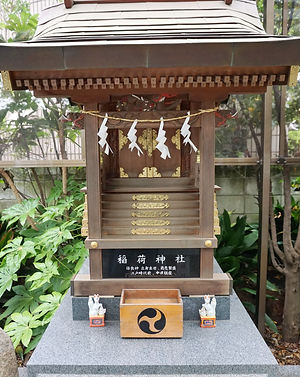普通の外にいくつかの著名な品質を持っている、と畏敬の念を起こさせるあるいかなるビーイングは、カミと呼ばれています。
Nearest station
Ogikubo
Marunouchi/Chuō Lines
Tōkyō-to, Suginami-ku, Amanuma 2-40-2
東京都杉並区天沼2-40-2
天沼熊野神社
Amanuma Kumano Jinja
Home page: (Japanese)
July 3, 2018
Enshrined Kami:
Main
(Note: numbers in parentheses after kami names
refer to position in How Many Kami table)
From Merged Shrines
None
In-ground Shrines:
Suga Jinja 須賀神社
Mitsumine Jinja 三峯神社
Taigen Jinja 太現神社
Inari Jinja 稲荷神社
Shiratama Inari Jinja 白玉稲荷神社
Annual Festival: August 12
History
There are two origins given for this shrine, the first in 768, the second in 1333. On the former occasion, it is said that when an official who was patrolling the Tōkaidō arrived in the area he established a way station and named it Amanuma-eki (乘潴驛), he also recognized a local deity.
The latter date is when the Hōjō-controlled Kamakura fell to the forces led by Nitta Yoshisada (新田義貞), the father of Nitto Yoshioki who we came across in connection with Onnazuka Jinja. En route to besieging Kamamkura, Yoshisada set up camp in the area and built a shrine, at which, perhaps not unnaturally, he prayed for success in his campaign and planted two Japanese cedar (sugi) trees.


In 1395 a samurai by the name of Asakura Mikawakami (朝倉三河守) returned to the area to resume his life of farming, and among other things rebuilt the shrine and named it Jūnisha Gengon (十二社権現). After the Meiji Restoration the name was changed to Kumano Jinja and in March 1874 it was given Village Shrine status.
Description
Five minutes or so on foot from Amanuma Hachiman Jinja. As with that shrine the most interesting aspect of this shrine is its five in-ground shrines. The Shiratama Inari Jinja is on the right as one enters the shrine, while the other four are grouped together in a small compound. Three of the four, Mitsumine, Taigen, and Suga, occupy the same shrine building. It is said that the kami of the second of the three, Taigen-mikoto-Ōkami (太現尊大神) was the first kami to be worshipped in Ananuma. Flanking the shrines on one side are two chikara ishi and on the other by the stubs of the two sugi trees planted by Nitta Yoshisada. These flourished for over 600 years before finally withering in 1946.
(Click on images to expand them)








Inari Jinja



Mitsumine Jinja Taigen Jinja Suga Jinja

Shiratama Inari Jinja







